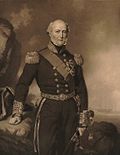| Royal Navy Burying Ground | |
|---|---|
 Royal Navy Burying Ground, Halifax, Nova Scotia | |
 | |
| Details | |
| Established | 1781 |
| Location | |
| Country | Canada |
| Coordinates | 44°39′41″N63°35′30″W / 44.661331°N 63.591574°W |
| Type | Closed |
| Owned by | Naval Museum of Halifax |
| No. of graves | 400+ |
| Website | Official website |
| Find a Grave | Royal Navy Burying Ground |
The Royal Navy Burying Ground is part of the Naval Museum of Halifax and was the Naval Hospital cemetery for the North America and West Indies Station at Halifax, Nova Scotia. It is the oldest military burial ground in Canada. The cemetery has grave markers to those who died while serving at Halifax and were treated at the Naval medical facility or died at sea. Often shipmates and officers had the grave markers erected to mark the deaths of the crew members who died while in the port of Halifax.
Contents
- Flagships of the North America and West Indies Station (1836–1869)
- Crew of HMS Vernon (1836)
- Crew of HMS Melville (1837)
- Crew of HMS Vindictive (1845)
- Crew of HMS Wellesley (1850)
- Crew of HMS Cumberland (1852)
- Crew of HMS Indus (1859)
- Crew of HMS Nile (1861)
- Crew of HMS Duncan (1866)
- Crew of HMS Royal Alfred (1869)
- Officers
- Other
- Individual crew members
- Multiple crew members
- Women and children
- War of 1812
- Crew of HMS Shannon (1813)
- Crew of USS Chesapeake (1813)
- See also
- Footnotes
- References
The number of burials is estimated at over 400, however, there are only 89 stone markers remaining. [1] There was a register of deaths established in 1860 for the burial ground. As well, surgeons of a ship registered the deaths of crew members, including how the person died and where they were buried. These reports were entered in the official register, with a detailed account sent quarterly to the Medical Director-General, Admiralty, England. [fn 1] There is no local record of who is buried. The four most common causes of death in order are: disease, falling from the topmast, drowning, and death as a result of naval battles.
Along with two monuments that commemorate casualties of the War of 1812, [3] the most prominent markers are for the crew that died on the flagships of the North American and West Indies Station: HMS Winchester (1841), HMS Wellesley (1850), HMS Cumberland (1852), HMS Indus (1859), HMS Nile (1861), HMS Duncan (1866), and HMS Royal Alfred (1869). There were many buried during the wars of the 18th century (American Revolution, French Revolutionary War and Napoleonic Wars) that do not have grave markers.











































